
![]()
 Home
Home
 |
The Parmigiano-Reggiano |
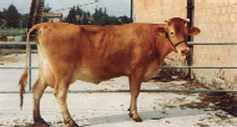
A fundamental element for the production of Parmigiano-Reggiano cheese is the milk originating from farms that respect severe standards regarding the hygene and selection of cattle. Particular care is taken in their nourishment, which comes from fresh, locally-grown, high-qua1ity feed, ensuring the production of exce11ent-qua1ity milk which can be used without pasteurization and without the addition of preservatives or other additives. 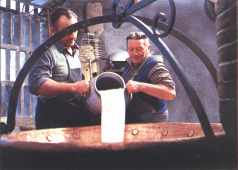 In the production ofParmigiano-Reggiano cheese the milk from both morning and evening milkings is used. The milk from the evening milking is placed in large vats where it settles for the entire night. In the morning the cheesemaker skims the whey (cream) which has surfaced, replacing it with additional milk from the morning milking. The exact proportion of milk used from morning and evening milkings is up to the cheesemaker, who takes into account the ambient conditions, the type of milk used, and other factors. The success of the final result is already dependent on this phase of production. At this point the milk is ready to be transferred to large, copper cauldrons capable of holding the 1200kg of milk necessary for the production of just two forms of cheese. Fermented whey, consisting of a naturally-grown bacterial culture applied to the whey from the previous process, is added to the milk.
In the production ofParmigiano-Reggiano cheese the milk from both morning and evening milkings is used. The milk from the evening milking is placed in large vats where it settles for the entire night. In the morning the cheesemaker skims the whey (cream) which has surfaced, replacing it with additional milk from the morning milking. The exact proportion of milk used from morning and evening milkings is up to the cheesemaker, who takes into account the ambient conditions, the type of milk used, and other factors. The success of the final result is already dependent on this phase of production. At this point the milk is ready to be transferred to large, copper cauldrons capable of holding the 1200kg of milk necessary for the production of just two forms of cheese. Fermented whey, consisting of a naturally-grown bacterial culture applied to the whey from the previous process, is added to the milk. 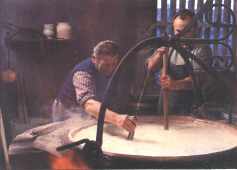 This ancient practice increases the degree of souring of the milk and in so doing ensures the cheese reaches an adequate degree of fermentation. Subsequently the product is heated to 30-35"C during which time the cheesemaker mixes the contents of the cauldron continuously to ensure uniform heat distribution. Once the heating is stopped, rennet (a natural coagulant derived from the stomach lining ofcalves) is added, and in 12-15 minutes the coagulation of the casein in the milk is obtained. Thus, in just under half an hour, the coagulation of the milk is obtained as ifby magic. The product of the coagulation is called "cagliata" (curd), the most nutritious part of milk.
This ancient practice increases the degree of souring of the milk and in so doing ensures the cheese reaches an adequate degree of fermentation. Subsequently the product is heated to 30-35"C during which time the cheesemaker mixes the contents of the cauldron continuously to ensure uniform heat distribution. Once the heating is stopped, rennet (a natural coagulant derived from the stomach lining ofcalves) is added, and in 12-15 minutes the coagulation of the casein in the milk is obtained. Thus, in just under half an hour, the coagulation of the milk is obtained as ifby magic. The product of the coagulation is called "cagliata" (curd), the most nutritious part of milk.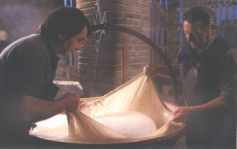 The cheesemaker begins to fragment the curd with a special instrument until it becomes a consistent, well-distributed grain. This process is undertaken at low heat until a maximum temperature of 560C is reached; by this time the grain has assumed a brownish tinge and a reasonable consistency. Once the heat is turned off, the cheesemaker ably collects the "cagliata" (curd) from the bottom of the cauldron using a wooden shovel, placing it on a filtering sheet of hemp. In this manner a large ball is formed, which when divided in half and placed in appropriate forms wrapped in hemp, will give rise to two forms of Parmigiano-Reggiano cheese. The forms will be left for three days before salting, during which time they are periodically turned over.
The cheesemaker begins to fragment the curd with a special instrument until it becomes a consistent, well-distributed grain. This process is undertaken at low heat until a maximum temperature of 560C is reached; by this time the grain has assumed a brownish tinge and a reasonable consistency. Once the heat is turned off, the cheesemaker ably collects the "cagliata" (curd) from the bottom of the cauldron using a wooden shovel, placing it on a filtering sheet of hemp. In this manner a large ball is formed, which when divided in half and placed in appropriate forms wrapped in hemp, will give rise to two forms of Parmigiano-Reggiano cheese. The forms will be left for three days before salting, during which time they are periodically turned over.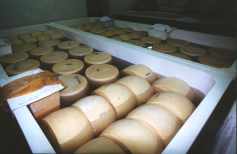 After salting, obtained by immersion in a solution of table salt and water, the forms are stored on speciai wooden shelves in the cheesemaking facility, ready for the long resting period which will last at least two years. During this time they will be checked, turned over, and scraped at least once every two weeks. This seasoning period is an extremely important step in obtaining a good-quality Parmigiano-Reggiano cheese. Such a long seasoning period, which is not undertaken with any other cheese, permits the particular transformation processes and break-down of proteins that gives the Parmigiano-Reggiano cheese its unimitable nutritional qualities and aroma.
After salting, obtained by immersion in a solution of table salt and water, the forms are stored on speciai wooden shelves in the cheesemaking facility, ready for the long resting period which will last at least two years. During this time they will be checked, turned over, and scraped at least once every two weeks. This seasoning period is an extremely important step in obtaining a good-quality Parmigiano-Reggiano cheese. Such a long seasoning period, which is not undertaken with any other cheese, permits the particular transformation processes and break-down of proteins that gives the Parmigiano-Reggiano cheese its unimitable nutritional qualities and aroma.
 In the production ofParmigiano-Reggiano cheese the milk from both morning and evening milkings is used. The milk from the evening milking is placed in large vats where it settles for the entire night. In the morning the cheesemaker skims the whey (cream) which has surfaced, replacing it with additional milk from the morning milking. The exact proportion of milk used from morning and evening milkings is up to the cheesemaker, who takes into account the ambient conditions, the type of milk used, and other factors. The success of the final result is already dependent on this phase of production. At this point the milk is ready to be transferred to large, copper cauldrons capable of holding the 1200kg of milk necessary for the production of just two forms of cheese. Fermented whey, consisting of a naturally-grown bacterial culture applied to the whey from the previous process, is added to the milk.
In the production ofParmigiano-Reggiano cheese the milk from both morning and evening milkings is used. The milk from the evening milking is placed in large vats where it settles for the entire night. In the morning the cheesemaker skims the whey (cream) which has surfaced, replacing it with additional milk from the morning milking. The exact proportion of milk used from morning and evening milkings is up to the cheesemaker, who takes into account the ambient conditions, the type of milk used, and other factors. The success of the final result is already dependent on this phase of production. At this point the milk is ready to be transferred to large, copper cauldrons capable of holding the 1200kg of milk necessary for the production of just two forms of cheese. Fermented whey, consisting of a naturally-grown bacterial culture applied to the whey from the previous process, is added to the milk.  This ancient practice increases the degree of souring of the milk and in so doing ensures the cheese reaches an adequate degree of fermentation. Subsequently the product is heated to 30-35"C during which time the cheesemaker mixes the contents of the cauldron continuously to ensure uniform heat distribution. Once the heating is stopped, rennet (a natural coagulant derived from the stomach lining ofcalves) is added, and in 12-15 minutes the coagulation of the casein in the milk is obtained. Thus, in just under half an hour, the coagulation of the milk is obtained as ifby magic. The product of the coagulation is called "cagliata" (curd), the most nutritious part of milk.
This ancient practice increases the degree of souring of the milk and in so doing ensures the cheese reaches an adequate degree of fermentation. Subsequently the product is heated to 30-35"C during which time the cheesemaker mixes the contents of the cauldron continuously to ensure uniform heat distribution. Once the heating is stopped, rennet (a natural coagulant derived from the stomach lining ofcalves) is added, and in 12-15 minutes the coagulation of the casein in the milk is obtained. Thus, in just under half an hour, the coagulation of the milk is obtained as ifby magic. The product of the coagulation is called "cagliata" (curd), the most nutritious part of milk. The cheesemaker begins to fragment the curd with a special instrument until it becomes a consistent, well-distributed grain. This process is undertaken at low heat until a maximum temperature of 560C is reached; by this time the grain has assumed a brownish tinge and a reasonable consistency. Once the heat is turned off, the cheesemaker ably collects the "cagliata" (curd) from the bottom of the cauldron using a wooden shovel, placing it on a filtering sheet of hemp. In this manner a large ball is formed, which when divided in half and placed in appropriate forms wrapped in hemp, will give rise to two forms of Parmigiano-Reggiano cheese. The forms will be left for three days before salting, during which time they are periodically turned over.
The cheesemaker begins to fragment the curd with a special instrument until it becomes a consistent, well-distributed grain. This process is undertaken at low heat until a maximum temperature of 560C is reached; by this time the grain has assumed a brownish tinge and a reasonable consistency. Once the heat is turned off, the cheesemaker ably collects the "cagliata" (curd) from the bottom of the cauldron using a wooden shovel, placing it on a filtering sheet of hemp. In this manner a large ball is formed, which when divided in half and placed in appropriate forms wrapped in hemp, will give rise to two forms of Parmigiano-Reggiano cheese. The forms will be left for three days before salting, during which time they are periodically turned over. After salting, obtained by immersion in a solution of table salt and water, the forms are stored on speciai wooden shelves in the cheesemaking facility, ready for the long resting period which will last at least two years. During this time they will be checked, turned over, and scraped at least once every two weeks. This seasoning period is an extremely important step in obtaining a good-quality Parmigiano-Reggiano cheese. Such a long seasoning period, which is not undertaken with any other cheese, permits the particular transformation processes and break-down of proteins that gives the Parmigiano-Reggiano cheese its unimitable nutritional qualities and aroma.
After salting, obtained by immersion in a solution of table salt and water, the forms are stored on speciai wooden shelves in the cheesemaking facility, ready for the long resting period which will last at least two years. During this time they will be checked, turned over, and scraped at least once every two weeks. This seasoning period is an extremely important step in obtaining a good-quality Parmigiano-Reggiano cheese. Such a long seasoning period, which is not undertaken with any other cheese, permits the particular transformation processes and break-down of proteins that gives the Parmigiano-Reggiano cheese its unimitable nutritional qualities and aroma.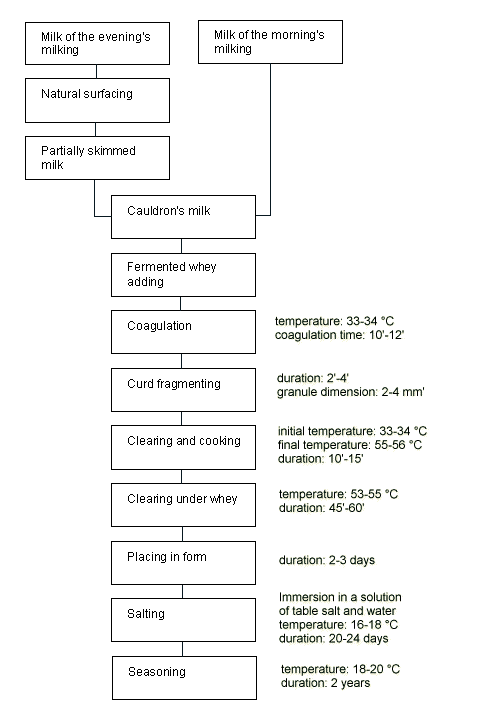
E-mail: info@parmigiano.it